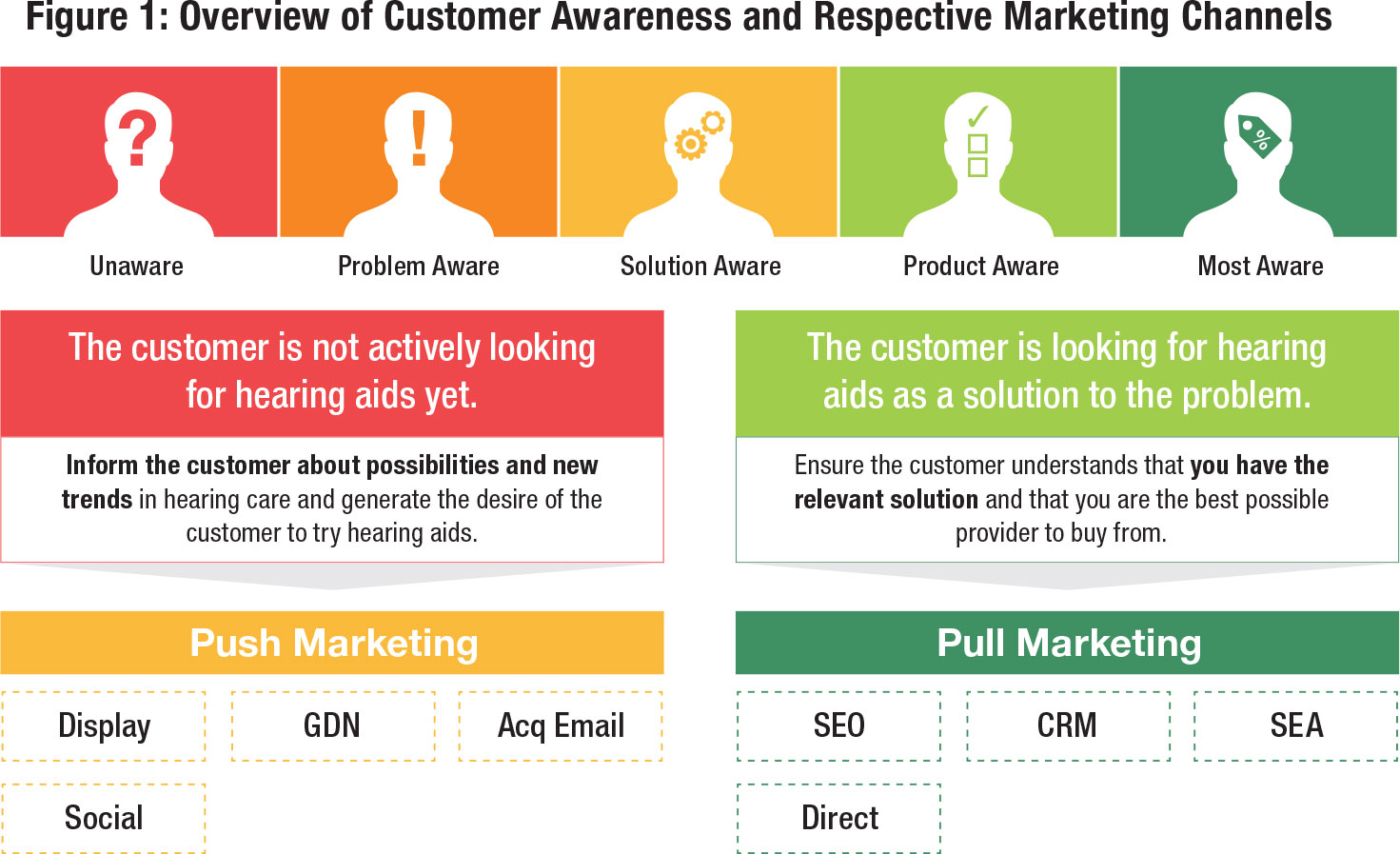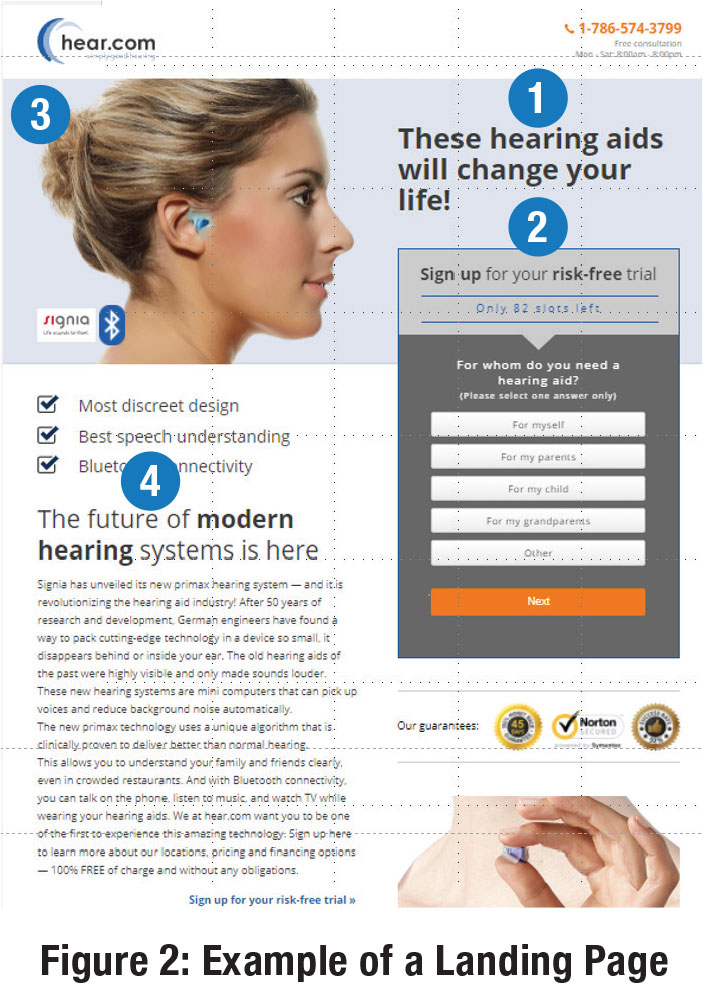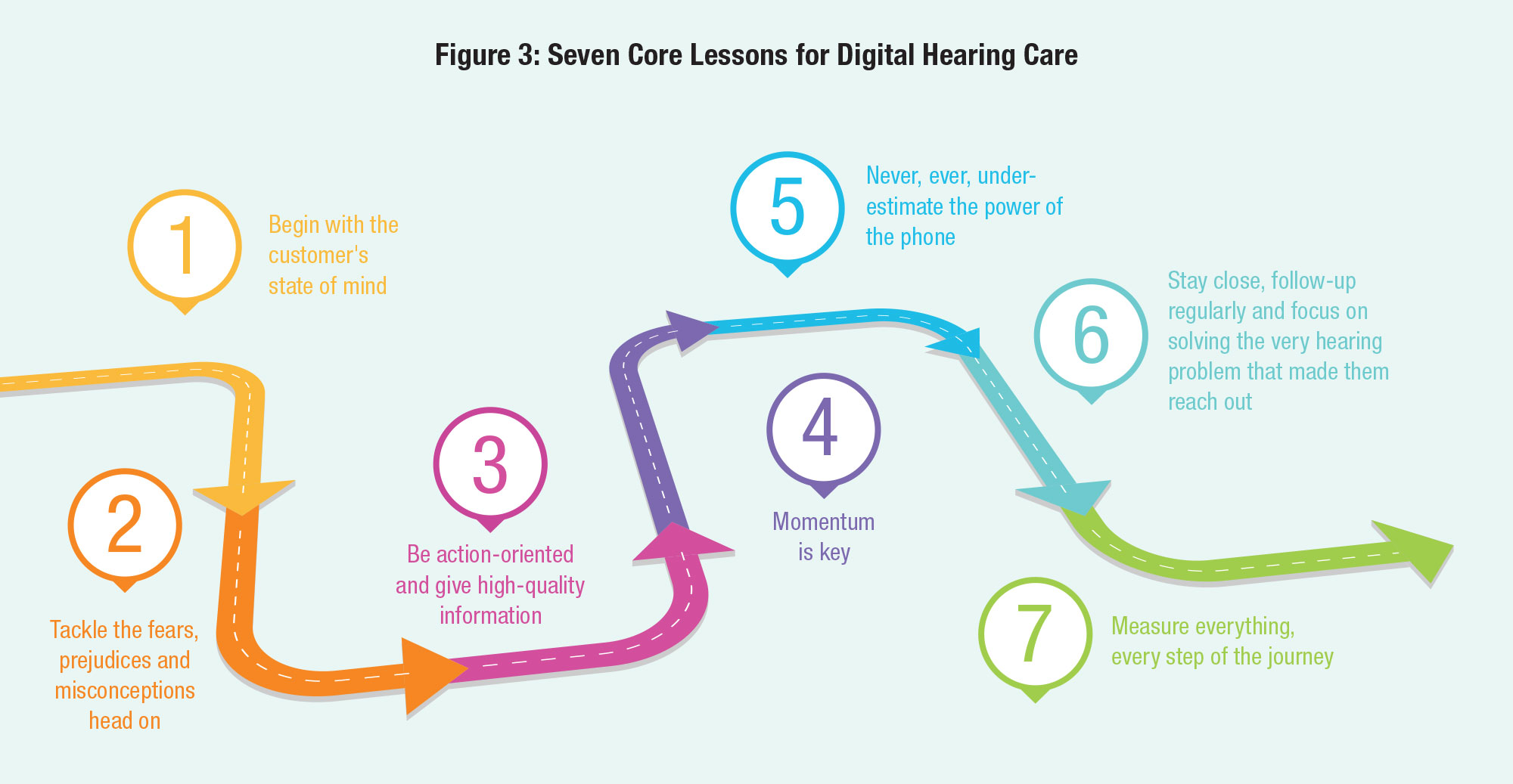
A Field Guide to Digital Marketing in Audiology
Alexander Evertz
This article provides essential insights and guidance on digital marketing tailored for your audiology practice. It covers fundamental digital marketing concepts, from understanding various marketing channels and tracking performance to mastering customer relationship management. Drawing on years of experience from hear.com’s digital hearing care model, we offer practical advice to start and improve your practice’s digital marketing strategies.
Introduction
Today, people of all ages, from the young to the elderly, are actively engaging online. In 2023, according to Pew Research, 96% of individuals aged 50-64 and 88% of those 65 and older were active online within the United States, demonstrating a significant online presence among older generations. This trend underscores the importance of digital marketing for all businesses with an elderly target group, including your audiology practice. Its role extends beyond merely attracting more patients to foster growth; it also plays a critical part in raising awareness. In an industry where many potential customers have yet to act, digital marketing addresses the crucial challenge of ensuring that individuals experiencing hearing loss are aware of and easily access the benefits of hearing aids.
Begin with your customer’s state of mind
Understanding your customer’s state of mind is pivotal to effective marketing. Today’s consumers are not just looking for products; they are seeking solutions that seamlessly integrate into their lifestyles and address their specific concerns. In the context of audiology practice, this means recognizing the unique needs, emotions, and hesitations that potential hearing aid wearers might have.
Based on hear.com’s experience in the hearing care market, the current population of potential hearing aid customers can be generally characterized as:
- Connected: 50% of individuals over 50 spend more than 15 hours online per week. This group is active on online shopping platforms and social media, even more so than millennials.
- Affluent: They possess the financial means and willingness to invest in quality products. This demographic is projected to remain the most affluent generation until at least 2030.
- Busy: They lead busy lives and have limited time for lengthy processes.
- Younger: They are younger than previous generations of hearing aid users, typically between 50 and 70 years old, indicating a shift in the customer base.
- Demanding: Your customers expect the highest quality in both service and product and are not hesitant to compare options and voice their opinions.
- Active: They are often still professionally engaged, travel frequently, and participate in a variety of hobbies and social activities.
Different online marketing channels reach different customer groups
Marketing that is customer-centric goes beyond traditional selling points; it requires a deep understanding of the customers’ state-of-mind from being unaware of their hearing loss to the decision to seek assistance. The stage of awareness influences how potential customers can be engaged through various marketing strategies, divided broadly into “push”, and “pull” tactics, as illustrated in Figure 1.
In push marketing, the strategy is proactive and targets potential customers who may not yet be actively seeking hearing aids. The objective here is to spark interest and create awareness about hearing solutions. By informing them about the latest advancements and benefits of hearing care, we aim to cultivate a desire for hearing aids before the need becomes apparent. Effective channels for push marketing include display, Google Display Network (GDN), acquisition e-mail and social media.
Conversely, pull marketing targets individuals who acknowledge their hearing loss and are actively seeking solutions. These customers are in the decision-making phase, ready to interact with content that will lead them to a purchase. Pull marketing ensures these potential customers find compelling reasons to choose our audiology practice over competitors. Key channels for pull marketing include search engine optimization (SEO), customer relationship management (CRM), search engine advertising (SEA) and direct marketing.

Tackle the fears, prejudices, and misconceptions head-on
Stigma surrounding hearing aids consistently prevents people from addressing their hearing loss. Many hesitate or completely avoid seeking help due to deep-seated prejudices and stereotypes associated with hearing aids. Instead of ignoring these misconceptions, it’s crucial to tackle them head-on. The objective is to transform these biases into positive messages that capture customer interest, sparking moments of realization and surprise. These positive messages are consistently reinforced at every stage of the customer’s journey, from the initial advertisement through all subsequent appointments, ensuring a shift in perception.
Common Fears and Misconceptions
The most common prejudices against hearing aids arise from misconceptions about their appearance, functionality, and the associated stigma of hearing loss. These misconceptions largely stem from older models, which differ significantly from today’s advanced devices. Below are some of the most prevalent misconceptions:
Reframing Misconceptions into Positive Marketing
Below are a few examples of how to counteract the common misconceptions with effective marketing campaigns and positive reinforcement during appointments.
To combat the idea that “hearing aids are big and bulky,” marketing efforts should showcase sleek, invisible, in-theear models through compelling imagery. This helps to shift perceptions towards the discreet and advanced design of modern devices.
Addressing the belief that “hearing aids are only for old people,” marketing should highlight younger users and showcase modern features like Bluetooth connectivity. This can make the devices more relatable to a broader demographic.
To challenge the notion that “hearing aids are not worth the investment,” offering a free trial can be an effective way to demonstrate the immediate improvement in quality of life that these devices provide. In addition, it offers the customer the chance to experience the value of hearing care themselves.
Positive marketing is crucial, but it’s equally important to reinforce these messages across all subsequent touchpoints. This includes not just appointments, but also emails, SMS messages, and printed materials provided to the customer during the initial weeks of trying out new hearing aids.
Be action-oriented and give high quality information
 A landing page, like the one shown in Figure 2, is the designated entry point for a website, specifically designed to receive and convert traffic from marketing campaigns. Best practices recommend creating separate landing pages for different marketing channels or even specific campaigns. This strategic segmentation ensures that each landing page delivers messages tailored to resonate with the advertisement and channel from which the customer originated.
A landing page, like the one shown in Figure 2, is the designated entry point for a website, specifically designed to receive and convert traffic from marketing campaigns. Best practices recommend creating separate landing pages for different marketing channels or even specific campaigns. This strategic segmentation ensures that each landing page delivers messages tailored to resonate with the advertisement and channel from which the customer originated.
Furthermore, maintaining separate landing pages facilitates A/B testing—allowing marketers to experiment with various ad formats, headlines, and calls to action (CTAs). This structured separation helps marketers analyze which versions generate the most engagement and assess the success of individual campaigns.
A well-constructed landing page offers engaging, insightful content that not only informs but also motivates the visitor to take action, effectively transitioning them from casual browsers to potential customers.
- Headline: The headline is the first element that visitors encounter, so it must immediately capture their attention and align seamlessly with the ad copy that brought them to the page. This synchronization ensures that there is no disconnect between the visitor’s expectations and the page’s content, providing a smooth transition.
- Call to Action: The call to action should be distinctly clear and concise, ensuring that signing up feels like a logical step for the visitor. It must be prominently displayed on the page, utilizing strategic colors or placement to catch the eye immediately. Additionally, the process should involve minimal effort, presenting a low barrier to entry. For example, opting for a simple form fill-out rather than a phone call can significantly reduce hesitation.
- Image: The chosen image must feature the hearing aid, illustrating the product that customers are considering. It should grab the visitor’s attention and be strategically positioned to direct the viewer’s gaze towards the CTA. This placement optimizes the visual flow, smoothly guiding visitors toward the desired action and reinforcing a direct link between the product’s benefits and the call to action.
- Copy: The copy of the landing page should be short yet informative, providing essential information about the product and clarifying the reasons for the visitor to take the next step. This text should explain what the product is, its key benefits, and how it can solve the visitor’s particular needs or problems.
Momentum is Key
In today’s rapid information exchange (e.g., 30-second TikTok videos) and quick service environment (e.g., Amazon deliveries arriving at our doorstep within a day, sometimes hours), maintaining customer interest after their initial engagement is more important than ever. Once a customer has responded to your digital marketing efforts, timely follow-up actions are essential. This is comparable to managing a queue in a retail store; if the wait is too long, customers lose interest and may decide to take their business elsewhere.
It’s important to recognize that even if a consumer understands why a hearing aid is beneficial, this doesn’t necessarily mean they are ready to make a purchase. They may still harbor reservations, often operating under a ‘not yet’ mindset, constantly looking for reasons to delay action. Even in the late stages of the journey, they are still looking for ways out.
Momentum is particularly important for customers who come through online advertising. These individuals are often not as committed as those who might walk into your clinic in person. Reflecting on the customer awareness scale discussed previously, online customers typically fall into the earlier stages of awareness. They require more guidance and encouragement to move through the decision-making funnel compared to walk-in customers who have already taken more proactive steps towards purchasing.
Never underestimate the power of the phone
Following up quickly after a customer has shown interest is essential, as discussed in the previous chapter. While emails and SMS are efficient ways to reach out, they lack the personal touch that can make a significant difference in customer engagement. This is where the power of the phone comes into play.
A phone call adds a human element to the interaction, which can profoundly impact the customer’s experience. It allows for a real-time, two-way dialogue that not only confirms details or schedules appointments but also delves deeper into the customer’s needs and the reasons behind their interest.
This human touch point is crucial; it introduces a personal dimension that automated messages simply cannot replicate. The voice of a friendly, knowledgeable expert on the other end of the line can elevate initial curiosity to serious consideration. While not necessarily prompting an immediate purchase of hearing aids, this interaction can encourage a commitment to visit your clinic for further discussion.
Stay close, follow-up regularly and focus on solving the very hearing problem that made them reach out.
Digital marketing does more than just attract new patients to your practice; it’s a crucial tool for nurturing longterm relationships that boost customer satisfaction and promote business growth. It’s essential to maintain ongoing communication with your customers, whether they’ve previously purchased hearing aids or disengaged during the process previously. Each interaction should be viewed as an opportunity to deepen the relationship.
In this context, it is vital to leverage technology to its fullest potential. Utilizing a CRMsystem can play a pivotal role here. Your CRM isn’t just a tool for organizing customer information; it’s a powerful marketing channel that helps personalize communication, track customer engagement, and anticipate needs based on past interactions.
A well-managed CRM system is arguably the most powerful marketing channel available. Over time, a robust CRM strategy can generate 40-50% of your business, making it not only the most impactful but also the most cost-effective channel. Given its significant potential for business growth and customer retention, your CRM system deserves special focus.
Measure everything, every step of the journey
Tracking and analyzing every facet of your online marketing efforts is critical to understanding the effectiveness of each dollar spent. By meticulously measuring various metrics, businesses can pinpoint which campaigns are successful and which should be discontinued.
To effectively manage your digital strategy, focus on several key performance indicators (KPIs), including quantitative metrics, conversion rates, and customer satisfaction. Quantitative metrics provide insights into the growth and scale of your online business, offering a comprehensive view of your overall progress. Conversion rates are essential for assessing the efficacy of your marketing tactics, pinpointing the stages at which potential customers may be dropping out, and identifying opportunities for optimization. Lastly, measuring customer satisfaction is critical for evaluating the quality of the experience you deliver, which is pivotal for customer retention and enhancing your brand’s reputation.
Tracking Key Performance Indicators along the customer journey
The customer journey typically begins with ad views and website visits, metrics tracked using tools like Google Analytics. Ad views count the number of times your ads are displayed, offering insights into your campaign’s reach. Tracking the number of unique website visitors helps assess how effectively these ads and your organic search efforts are attracting traffic.
As the journey progresses, linking generated leads, booked appointments, and sales directly to your marketing campaigns is crucial. This connection is key to understanding the effectiveness of different channels and campaigns. Although aggressive marketing might initially drive traffic, it can also lead to higher dropout rates later on. Therefore, it is important to track net sales, excluding any customers returning their hearing aids.
As you expand your marketing, it’s crucial to monitor conversion rates at each stage of the customer journey. Tracking these rates helps pinpoint where potential customers are dropping out and highlights opportunities for improvement. For example, the click-through rate (CTR) measures the percentage of viewers who click on your ads, indicating how compelling your ads are. It’s also important to track conversions from visitor to lead, lead to appointment, and appointment to sale. Low conversion rates at any stage of the customer journey may indicate that a specific touchpoint isn’t optimized, doesn’t fully meet customer expectations, or that earlier stages may not align perfectly. For example, if you advertise a hearing test but primarily promote hearing aids, this mismatch could confuse potential customers, leading to drop-offs. Therefore, it’s crucial to ensure a coherent narrative links each touchpoint, smoothly guiding customers through the journey.
The financial efficiency of marketing campaigns is evaluated by tracking specific cost metrics such as cost per click (CPC), cost per lead (CPL), and cost per sale (CPS). The CPS metric is particularly relevant, as it indicates how much you need to invest in online marketing to generate one sale, thus providing a clear measure of your marketing activity’s profitability.
Introducing the net promoter score
The Net Promoter Score (NPS) is a standardized metric used across various industries to measure customer satisfaction and loyalty. The NPS was created by Bain consultant, Fred Reichheld, more than 20 years ago, and it is used by hundreds of businesses today as a gauge of customer satisfaction and loyalty. The NPS is based on a single question: “On a scale of 0-10, how likely are you to recommend our company/ product/service to a friend or colleague?” The simplicity of this question allows organizations to quickly gauge their customers’ overall perception and satisfaction with the service they are receiving.
NPS categorizes respondents into three groups based on their ratings:
- Promoters (score 9-10): Loyal enthusiasts who will keep buying and refer others, fueling growth.
- Passives (score 7-8): Satisfied but unenthusiastic customers who are vulnerable to competitive offerings.
- Detractors (score 0-6): Unhappy customers who can damage the brand and impede growth through negative word-of-mouth.
To calculate the NPS, subtract the percentage of detractors from the percentage of promoters. The result is a score ranging from -100 (if every customer is a detractor) to 100 (if every customer is a promoter).
NPS = (% of Promoters) − (% of Detractors)
As a benchmark, the Marketrak 2022 survey indicates that the average Net Promoter Score (NPS) in the US hearing care market for hearing aid owners is 25. In online marketing, building trust is crucial to convincing potential customers to enter their personal details on your website. They often consult review platforms such as Google, Trustpilot, and the Better Business Bureau to gauge the credibility and reliability of a company. Therefore, maintaining high customer satisfaction is crucial. The NPS serves as an effective tool for tracking customer satisfaction, helping you identify how well your business meets customer expectations and where improvements can be made to enhance the overall customer experience.

Conclusions
Although traditional forms of advertising such as print, television, and radio are still useful, digital marketing is now the norm for generating office traffic in an audiology practice. The various forms of digital marketing outlined here allow audiologists to communicate more consistently with prospective patients and to better understand their individual interests and needs. Consequently, audiology practices can add additional value by better understanding these individual needs. ■
Alexander Evertz, is the head of teleaudiometry for hear.com and is based in Denver, CO. He can be reached at alexander.evertz@ audibene.de.
